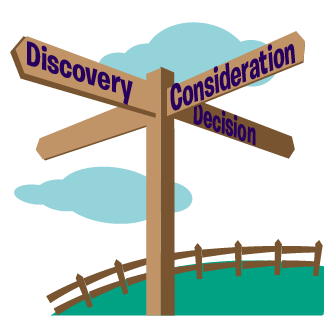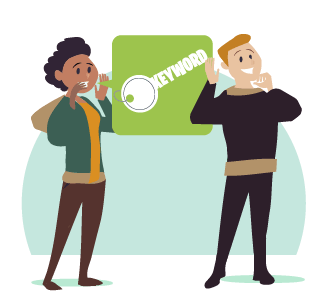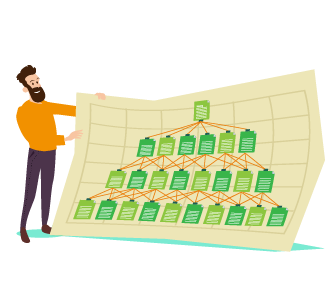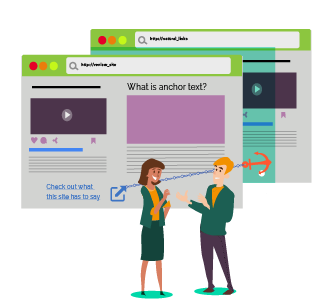Sometimes, when you are carrying out your SEO strategies, you end up fixated over the keywords and proper formatting on websites
It’s easy to forget that there are real human beings that are using Google to find the content that they want
A recent Forrester study shows that over 70% of consumers start their journey becoming from a prospect to a buyer by using Google search to discover new products or services.
In fact, nearly 49% of consumers rely on information gathered through web search to make their buying decisions.
This is why you should tailor your SEO accordingly to your buyer journey.
By becoming part of the prospect’s decision-making process and becoming readily available for them online, you can influence and persuade, and ultimately convert them into buyers.
What exactly is a buyer journey?
Marketers understand that the process of buying is a journey for consumers. Hence the term ‘buyer journey’ is coined to describe the whole process.
While different industries can lead to different buyer journeys, the blueprint for a typical buyer journey remains mostly the same.
The journey is a three-stage process:
- Awareness: The buyer realises that he has a problem and needs a product or service to fix the problem (a leaky pipe, a new office desk, flowers for a wedding, etc.)
- Consideration: The buyer defines their problem in detail and explores options to resolve it.
Based on research by HubSpot, it has been revealed that Google search is one of the primary places where consumers are researching their options the most.
- Decision: The buyer decides on the best solution to his problem.
Different people begin their buyer journey at various stages.
And because of this reason, if you are only publishing content that applies to just a single stage of the buyer journey, you are missing opportunities to sufficiently influence your prospects.
By applying your online content to the buyer journey framework, you can use your content to guide and move prospects through your sales funnel, converting them from prospects to customers.
As we have discussed in our SEO guide, the key to good SEO is about having the appropriate content that satisfies the Google user’s intent.
This is why your content needs to be highly relevant to each stage of the buyer journey to successfully move your prospects through your conversion funnel, whether it’s closing a sale, or getting a new subscriber.
Buyer Journey: Awareness
As this is the beginning stage of the buyer’s journey, your prospect is very likely to be unaware of your business, and that they don’t know that they have a need for your offering.
During the awareness stage, prospects are struggling with the following question: “How can I know I’m interested in what you are selling when I don’t even know you exist?”
This is why during the awareness phase, your priority is to make prospects know of your product, service, or business.
This lets your prospects understand what your company does, and how you can solve their problems.
You will also want to identify and drive into the prospects’ pain points – problems that they are experiencing – to make them more aware that they have a need of your product or service.
SEO in the Awareness Stage
During this stage, prospects will be running search terms that do not have a specific brand or name.
For example, a person is experiencing fine wrinkles around her eyes. She doesn’t like the way she looks, and she wants to fix it.
She would likely be Googling terms such as “crow’s feet cure,” “get rid of face wrinkles,” “reasons for face wrinkles,” “how to remove fine wrinkles.”
As you can see, questions raised during the awareness stage tend to be vague, generic and open-ended.
If you are a business that sells anti-wrinkle skin products, you need to start targeting search terms such as these and produce content that addresses these questions.
During this time, prospects are looking for info to educate themselves about their pain, and the solutions available. You should be producing content on your website to satisfy their intent.
How-To articles, list articles are great content to start off with. Also, you might want to consider creating other content mediums such as eBooks and PDF reports.
Prospects can download these contents and use as a guide for their research purposes. Having a diverse variety of material helps to cover your bases and reach a wider audience.
In the awareness stage, it is also common for prospects to not even know that they have a problem.
You need to bring to their attention the existence of their problem, and if possible, the dangers and risk for inaction.
Let’s say you are a business that sells gym equipment, you can produce content that talks about the danger of not exercising, or the harmful health impacts associated with overeating, etc.
Lastly, do note that during the awareness stage, prospects aren’t quite ready for a sales pitch, so you shouldn’t be making any hard-selling to your them, or you will be turning them away.
You should focus your content on educating and reminding prospects about the problems they face, and not about your product or service.
Buyer Journey: Consideration
By publishing relevant and timely content on your website, visitors and leads who find your content helpful towards their research are primed to move up to the 2nd stage of the buyer journey: consideration.
This is the point that takes place after prospects are aware of their problems, and they understand the options they can choose.
This is where they weigh all their options, whittling away the choices that don’t suit their criteria until they have narrowed down to a short list.
The prospects haven’t quite made up their minds about which solution they want to take. They are taking into consideration such as how effective can these options solve their problems, the costs involved, the amount of time commitment, etc.
At this stage, people return to Google for at least 2 to 3 times to strengthen their previous research, to dive deeper into each company’s offerings and see if how well they can address their pain points.
Your job as a marketer is to continue to convince your prospects, by telling them how great a job your offering can fix their problems.
SEO in the Consideration Stage
Making comparisons is the name of the game here.
Prospects are looking to make sure they are getting the right product or service to solve their problems, before forking out their hard-earned money.
Prospects are also aware of specific names and brands, they will be using search terms such as “product X vs. product Y,” “buyer’s guide to product X,” product X review.”
You should publish content that will help your prospects narrow their options quickly, preferably with your offerings as one of the top choices.
Articles such as products showdown, buying guide, reviews are great in illustrating essential features of products or services from similar companies.
This is a good chance to highlight the key benefits of your offering over your competitors. If you have testimonials and glowing reviews from past customers or reviewers, this is a great time to include them at the end of your content.
The consideration stage is also the time where your prospects will have inquiries and questions about your product (things such as warranties, product lifespan, support, etc.).
Use your content to help answer these queries. You can conduct an AMA (ask me anything) styled article, or simply create a report that explains all the frequently-asked-questions about your product or service.
During the consideration stage, you should ramp up your selling efforts. Collecting email addresses through opt-in forms, spending advertising dollars on retargeting ads are both great strategies to maintain presence amongst your prospects.
Getting them to sign up for your emails allows you to step up on sending prospects relevant info right into their inboxes, or entice them further with discounts and promotions.
Retargeting prospects with ads will help remind them about your product or brand, keeping you at the top of their minds. It also helps to jog their memory about the key benefits of your offering.
Take note that, you don’t have to be overly pushy in your sales pitch, you just need to highlight the key features and benefits of your product.
You don’t need to strong-arm them into becoming your customers; you just need to nudge them gently so they can arrive upon the decision to hand you their money on their own volition.
Buyer Journey: Decision Stage
Once prospects have narrowed their options to a handful of choices, they are ready to take out their credit cards and hit the “Buy Now” button, right?
Not necessary.
This is why the decision stage is arguably the most crucial stage as it’s usually the one where you make the sale.
During the decision phase, prospects will still be doing their research into their purchase options because they want to be sure.
This is also the stage where prospects feel they need to slow down. They are telling themselves that they need to rethink their facts, to make sure they aren’t pulling the trigger on the wrong purchase.
If you have appropriately nurtured your leads in the previous two stages by lining up relevant content and communicating marketing messages consistently, then your calls-to-action (CTAs) should resonate well with your prospects.
That’s why your role as a marketer in the decision phase to convince your prospects that your company is the best solution to fix their problems.
SEO in the Decision Stage
For this stage, your content has to lean heavily on assuring the prospects that they are going to make the right decision by buying from you.
If you haven’t been producing brand-specific content, this is the time to do so.
Focus heavily on the positive experience that your past and current customers are having with your product or service.
This further adds to the assurance for your prospects, letting them know that a positive experience awaits them once they have bought from you.
At this stage, prospects will also want to hit the ground running once they have received your product.
This will also be the time to create content that informs the prospects about what they should expect after their purchase, and how they should use your product to maximise their benefits.
Useful content such as these help the prospects to see value in your product or service, and will likely win them over to become buyers, or even repeat ones.
Each piece of content that you put up for the decision stage has to demonstrate to your prospects the returns of investment (ROI) upon buying your offering.
Show prospects know what previous buyers have achieved using your product, by providing a steady number of case studies and interviews that prospects can read about.
You can also provide product literature such as user manuals, product comparison infographics, or even offer free trials to help prospects make up their mind.
Working SEO into the Buyer Journey is only the beginning
Maybe you’ve initially thought that your target audience was identical – with everybody sharing the same traits and also having the same wants and needs.
However, after looking at how the buyer journey works, it’s clear to see that every target prospect is different from one another.
Your prospects are made up of various segments of people, each of whom has different needs and questions.
If you can create a content marketing approach that caters to each segment, you’ll be able to generate better returns on your marketing.
One crucial thing to note that is even though the decision stage is the last step of the buyer journey, it is by no means the end.
In fact, it’s the only the beginning of an ongoing and growing relationship. This is where the journey no longer becomes just a straight line, but an endless cycle.
To ensure your business will continue to grow, you’ll need to continue keeping your buyers happy, and ultimately motivate them to come back to your business again.
Happy buyers make ambassadors for your brand, and they help to support your marketing efforts through word-of-mouth and other positive testimonials.
And for these reasons, you should always keep your website content active and updated, making it a trustworthy source of research, while selling your product or service to your prospects.







